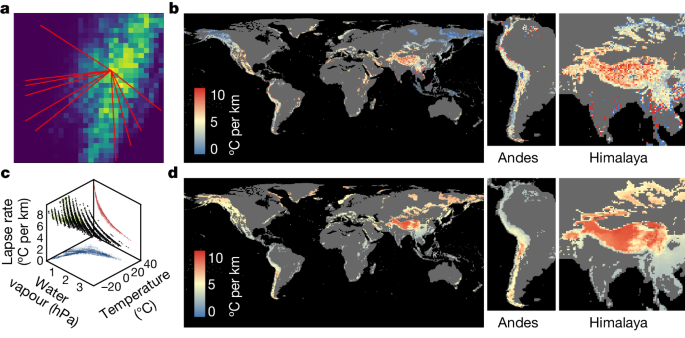Climate Change Impact on Mountain Species Tracking
Core Concepts
Mountain regions play a crucial role in biodiversity conservation, but climate change poses challenges to species tracking.
Abstract
Introduction:
Mountain ranges are vital for endemic and lowland species.
Climate change impacts species tracking in these regions.
Methodology:
Mapping lapse rate of temperature across mountain regions.
Using satellite data and thermodynamics laws for analysis.
Findings:
Identified 17 mountain regions with high isotherm shift velocities.
Species tracking closely related to climate velocities.
Some species lag behind in range shifts.
Implications:
Importance of global conservation strategies.
Focus on high-velocity mountain regions for conservation efforts.
Climate velocities and species tracking in global mountain regions - Nature
Stats
"greater than 11.67 m per year for the SLRT; greater than 8.25 m per year for the MALRT"
Quotes
"Mountain ranges contain high concentrations of endemic species and are indispensable refugia for lowland species facing anthropogenic climate change."
"Our findings are key for devising global conservation strategies, particularly in the 17 high-velocity mountain regions that we have identified."
Key Insights Distilled From
by Wei-Ping Cha... at www.nature.com 03-27-2024
https://www.nature.com/articles/s41586-024-07264-9
Deeper Inquiries
How can conservation efforts be tailored to address the challenges faced by species in high-velocity mountain regions
Conservation efforts in high-velocity mountain regions can be tailored by focusing on creating interconnected networks of protected areas that allow species to move and adapt to changing climates. Implementing habitat corridors that link different elevational zones can facilitate species migration. Additionally, targeted conservation actions such as assisted migration, where species are translocated to more suitable habitats, and captive breeding programs can help mitigate the challenges faced by species in rapidly changing environments. Collaborative efforts involving local communities, governments, and conservation organizations are essential to ensure the success of these tailored conservation strategies in high-velocity mountain regions.
What are the potential consequences of species lagging behind in range shifts in mountainous areas
The potential consequences of species lagging behind in range shifts in mountainous areas are significant and can lead to loss of biodiversity, disruption of ecosystem functioning, and increased extinction risk. As species fail to keep pace with shifting climates, they may face reduced access to suitable habitats, food sources, and breeding grounds, ultimately impacting their survival. This lag in range shifts can also result in altered species interactions, such as predator-prey relationships and competition for resources, leading to cascading effects throughout the ecosystem. Conservation efforts must address these consequences by prioritizing the protection and restoration of critical habitats and facilitating species movement to more suitable areas.
How can the findings of this study be applied to conservation efforts in other ecosystems
The findings of this study can be applied to conservation efforts in other ecosystems by providing valuable insights into the dynamics of species range shifts in response to climate change. By understanding the relationship between climate velocities and species tracking, conservationists can prioritize areas where species are likely to face challenges in adapting to changing environments. This knowledge can inform the design of conservation strategies that focus on enhancing habitat connectivity, promoting genetic diversity, and facilitating species resilience to climate change impacts. Furthermore, the identification of high-velocity mountain regions can serve as a model for assessing climate velocities in other ecosystems, guiding conservation actions on a global scale.
0
